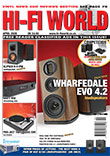Cartridges |
|
CARTRIDGES
Our quick and simple guide to pickup cartridges
To play LPs you need a cartridge: It traces the grooves mechanically with a stylus on a cantilever. Inside, a small electrical signal is produced that needs a lot of amplification. The cartridge fits to the arm with two small holding screws. Most common is the MM or Moving Magnet type. For top quality consider an MC or Moving Coil type. There have been many other types over the years, the strain gauge cartridge being one that is still available from Soundsmith. And then there is the Finial - now ELP of Japan - laser turntable that reads the groove with a laser. The signal from an MC is very small, so a low noise phono preamplifier is needed. Amplifiers with a Phono input have it built in, but high quality external preamps of plentiful. They boost the weak signal and apply equalisation. External preamps plug into an amplifier’s AUX input. MC cartridges need ten times more boost than MMs, so need a dedicated MC preamp. It is common for external phono stages to be switchable from MM to MC.
Electrical connection pins at the rear of a cartridge MOVING MAGNET, or MM cartridges (typically £25-£400)
Simple and inexpensive, and with a removable stylus, so if you damage the delicate stylus assembly, a replacement is cheap and you can fit it yourself. Good hi-fi cartridges range from Nagaoka’s MP15 at £25 up to Ortofon’s 2M Black at £400. The MP15 is lovely and the Black is wonderful, so get a decent MM cartridge and don’t worry about MCs unless you want to ascend the ladder to audio heaven - and pay for the privilege. Older designs like the Nagaoka MP15 and Shure M97Xe track well but sound ‘warm’. Newer designs like the Goldring 1012-1042 range and Ortofon 2M range track well and are tonally accurate. Benefits Inexpensive to buy and run – up to £400 User replaceable stylus Sounds very good and can be tonally accurate Drawbacks Lacks the transparency of an MC Less cohesive than top MCs Lacks the three-D sound stage of top MCs
MOVING COIL, or MC cartridges ((typically £180 - £5000)
The Moving Coil cartridge is an altogether more expensive but potentially beautiful sounding cartridge. But beware. They come in many varieties, and cheap ones are conceptually inept and best avoided (see our Technology category).
The moving coil cartridge does not have a user replaceable stylus (with some exceptions), so if you bounce it, you send it back for repair - and this can be costly, as well as a hassle. It’s best to find out how the manufacturer (only Goldring in the UK) or importer deals with this, since Ortofons are made in Denmark, Lyra and Audio Technica in Japan, for example . MCs produce roughly one-tenth the output of an MM so they need special preamps – more cost. But if you can cope with all this, then the MC is heaven achieved. Benefits Walk around sound stage Superbly clear and natural Uncoloured Drawbacks Expensive: £400-£4000 Needs special preamp: £200-£2000 Delicate
MC VARIANTS
High Output MC (1) - produces almost the same output as an MM so it can be used with an ordinary MM preamp. Often tracks badly and sounds no better than a mediocre MM. High Output MC (2) - yes, the same description as above, which is confusing. However, these are often well engineered MCs – typically Ortofons – that have more output (0.7mV) than many rivals (0.2mV). They are not MM replacements and are not for use with an MM phono stage; their benefit is lower hiss through MC stages. |










